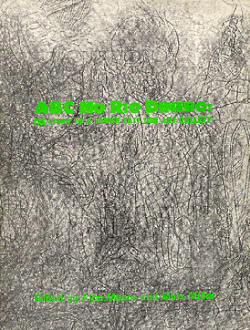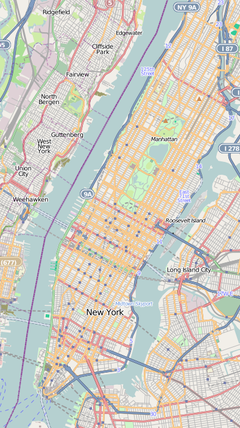No wave was an avant-garde music and visual art scene which emerged in the late 1970s in downtown New York City. The term was a pun based on the rejection of commercial new wave music. Reacting against punk rock's recycling of rock and roll clichés, no wave musicians instead experimented with noise, dissonance, and atonality, as well as non-rock genres like free jazz, funk, and disco. The scene often reflected an abrasive, confrontational, and nihilistic worldview.
Anarcho-punk is an ideological subgenre of punk rock that promotes anarchism. Some use the term broadly to refer to any punk music with anarchist lyrical content, which may figure in crust punk, hardcore punk, folk punk, and other styles.

CBGB was a New York City music club opened in 1973 by Hilly Kristal in Manhattan's East Village. The club was previously a biker bar and before that was a dive bar. The letters CBGB were for Country, BlueGrass, and Blues, Kristal's original vision, yet CBGB soon became a famed venue of punk rock and new wave bands like the Ramones, Television, Patti Smith Group, Blondie, and Talking Heads. From the early 1980s onward, CBGB was known for hardcore punk.

Tom Otterness is an American sculptor best known as one of America's most prolific public artists. Otterness's works adorn parks, plazas, subway stations, libraries, courthouses and museums around the world, notably in New York City's Rockefeller Park in Battery Park City and Life Underground in the 14th Street – Eighth Avenue New York Subway station. He contributed a balloon to the Macy's Thanksgiving Day Parade. In 1994 he was elected as a member of the National Academy Museum.
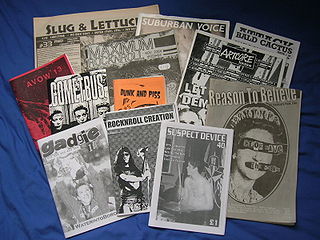
Punk visual art is artwork associated with the punk subculture and the No wave movement. It is prevalent in punk rock album covers, flyers for punk concerts and punk zines, but has also been prolific in other mediums, such as the visual arts, the performing arts, literature and cinema. Punk manifested itself "differently but consistently" in different cultural spheres. Punk also led to the birth of several movements: new wave, no wave, dark wave, industrial, hardcore, queercore, etc., which are sometimes showcased in art galleries and exhibition spaces. The punk aesthetic was a dominant strand from 1982 to 1986 in the many art galleries of the East Village of Manhattan.
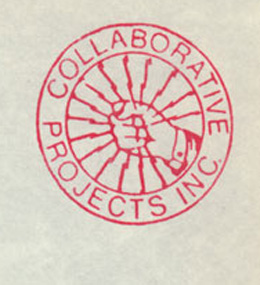
Colab is the commonly used abbreviation of the New York City artists' group Collaborative Projects, which was formed after a series of open meetings between artists of various disciplines.
Charm City Art Space39°18′33.5″N76°37′4″W is a music venue/art space located at 1731 Maryland Avenue, in Baltimore, Maryland, in the Station North arts district. This area is home to several do it yourself (DIY) projects, including the Velocipede Bike Project, and the Jerk Store. It is also known as the space, the art space, or CCAS.
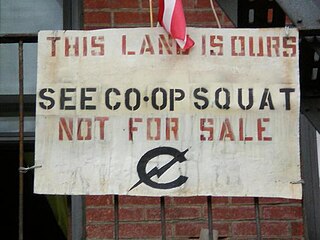
C-Squat is a former squat house located at 155 Avenue C in the Alphabet City neighborhood of Manhattan, New York City that has been home to musicians, artists, and activists, among others. After a fire, it was taken into city ownership in 1978 and squatters moved in in 1989. The building was restored in 2002 and since then it has been legally owned by the occupants. Its ground-floor storefront now houses the Museum of Reclaimed Urban Space.

Carlo McCormick is an American culture critic and curator living in New York City. He is the author of numerous books, monographs and catalogues on contemporary art and artists.
The Mr. Roboto Project is an all-ages, Do It Yourself (DIY), nonprofit volunteer-run cooperative venue and show space in Pittsburgh, Pennsylvania. Since the fall of 2011, it has been located at 5106 Penn Avenue. The structure of The Mr. Roboto Project was modeled partially after the 924 Gilman St club in Berkeley, CA, combined with elements of the East End Food Co-op in Pittsburgh, PA.

Walter Robinson is a New York City-based painter, publisher, art curator and art writer. He has been called a Neo-pop painter, as well as a member of the 1980s The Pictures Generation.
James Allan Curtis, known professionally as Diego Cortez, was an American filmmaker and art curator closely associated with the no wave period in New York City. Cortez was the co-founder of the Mudd Club, and he curated the influential post-punk art show New York/New Wave, which brought the then aspiring artist Jean-Michel Basquiat to fame.
Alan W. Moore is an art historian and activist whose work addresses cultural economies and groups and the politics of collectivity. After a stint as an art critic, Moore made video art and installation art from the mid-1970s on and performed in the 1979 Public Arts International/Free Speech series. He has published several books and runs the House Magic information project on self-organized, occupied autonomous social centers. His partial autobiography was published in 2022 in The Journal of Aesthetics & Protest as Art Worker: Doing Time in the New York Artworld. Moore lives in Madrid.
Coleen Fitzgibbon is an American experimental film artist associated with Collaborative Projects, Inc.. She worked under the pseudonym Colen Fitzgibbon between the years 1973–1980. Fitzgibbon currently resides on Ludlow Street in New York City and in Montana.
Joe Lewis is a post-conceptual non-media specific American artist and educator. Lewis was co-founding director of Fashion Moda in New York, where he curated and mounted numerous exhibitions and performance events. He also early on has been associated with Colab and ABC No Rio

The Real Estate Show was a squatted exhibition by New York artists' group Colab, on the subject of landlord speculation in real estate held on New Year's Day in a vacant city-owned building at 123 Delancey Street in the Lower East Side of Manhattan, New York City.
Jolie Stahl is an American painter, sculptor, printer, and photographer. She has worked as a journalist and anthropologist.

The Times Square Show was an influential collaborative, self-curated, and self-generated art exhibition held by New York artists' group Colab in Times Square in a shuttered massage parlor at 201 W. 41st and 7th Avenue during the entire month of June in 1980. The Times Square Show was largely inspired by the more radical Colab show The Real Estate Show, but unlike it, was open 24 hours a day, 7 days a week, in what was then a Times Square full of porno theaters, peep shows, and red light establishments. In addition to experimental painting and sculpture, the exhibition incorporated music, fashion, and an ambitious program of performance and video. For many artists the exhibition served as a forum for the exchange of ideas, a testing-ground for social-directed figurative work in progress, and a catalyst for exploring new political-artistic directions.

Bullet Space is a legalized squat, artists’ collective and art gallery on the Lower East Side of New York City, founded in 1986 by Andrew and Paul Castrucci, among others. In 2009, it was legalized by the city.
